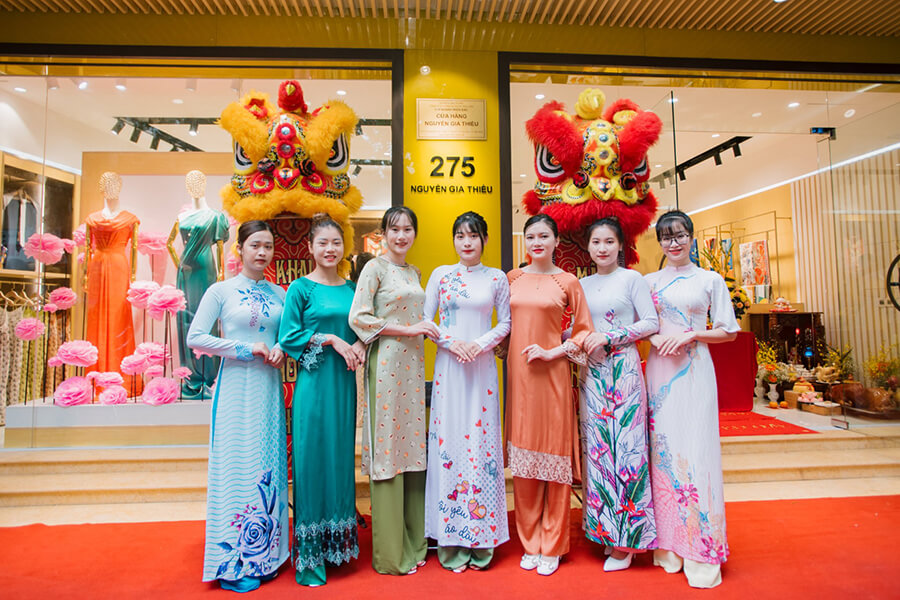Vietnam, a land steeped in a rich tapestry of history spanning nearly 4,000 years, proudly holds the mosaic of 54 ethnic groups. This colorful diversity is beautifully encapsulated in the breathtaking array of traditional costumes worn by its people. These garments serve as vibrant storytellers, each thread echoing tales of culture, elegance, and uniqueness.
The traditional costumes of Vietnam are not mere ensembles; they are living testaments to the amalgamation of influences from various corners of the globe throughout the country’s extensive history. They reflect a heritage interwoven with diverse cultural imprints that have shaped and defined the essence of Vietnam’s sartorial elegance.
Within these garments lies the essence of Vietnam’s cultural identity, echoing a symphony of historical narratives, customs, and rituals. The traditional attire not only adorns the people but also serves as a visual narrative, portraying the intricate layers of their society’s heritage.
Vietnamese traditional costumes have been fashioned by a confluence of influences, drawing from ancient legacies and embracing the interplay of various cultural encounters. They stand as a testament to the nation’s resilience and adaptive spirit, showcasing a harmonious blend of indigenous traditions and external influences from the annals of time.
To truly understand Vietnam’s soul, one must immerse in the stories spun by the intricate weavings, vibrant hues, and unique designs of its traditional costumes. These garments are not just fabrics and stitches; they are the embodiment of Vietnam’s cultural richness and the embodiment of the beautiful amalgamation of its people’s past and present.
So, embark on a journey with Vietnam Travel to delve deeper into the origins, history, and cultural significance encapsulated within the folds of these captivating traditional costumes. Unravel the enchanting tales that adorn the vibrant landscapes of Vietnam’s cultural heritage, etched elegantly in the seams of its traditional attire.
Áo Dài – Ao Dai
In the annals of Vietnamese heritage, the Ao Dai stands as an iconic emblem, revered both within the nation and beyond its borders. This majestic garment has transcended time, becoming a symbol of Vietnam’s cultural pride.
The genesis of the Ao Dai traces back to the illustrious 18th century, a period marked by the reign of the Nguyen Lords in Hue. It was during this time that the word “Ao Dai” found its inception. The astute ruler, seeking to distinguish his land from others and forge an identity of independence, recognized the stark resemblance between Vietnamese attire and the garments donned by the Chinese. This revelation spurred a decree to craft a distinct, indigenous costume, a testament to their autonomy.
The earliest iteration of the Ao Dai bore five flaps known as “than,” each intricately designed to exude symbolism and significance. Two front flaps, two at the back, and a singular “than” nestled within the front flaps were meticulously arranged. This quintet of flaps symbolized “Tu Than Phu Mau,” a profound representation denoting the perpetual guardianship of the four parents—both birth parents and parents-in-law—watching over and safeguarding their offspring.
Beyond its fabric and stitches, the Ao Dai represents a profound narrative embedded within the cultural ethos of Vietnam. It stands not merely as a piece of clothing but as a living testament to the country’s resilience, creativity, and spirit. This sartorial masterpiece, a fusion of elegance and cultural symbolism, encapsulates the ethos of a nation striving for identity and autonomy.
The Ao Dai, with its eloquent design and deeper connotations, encapsulates the essence of Vietnamese heritage, narrating a saga of cultural pride and the spirited ambition of a people striving for a distinct identity, resonating both with its wearers and the world that admires its grace.
The timeless Ao Dai, a quintessential symbol of Vietnamese cultural legacy, has traversed the winds of change over the passage of time, evolving through historical epochs and societal transitions.
Amidst the epoch of French colonialism, a visionary artist known as Cat Tuong, or Le Mur, wielded his creative prowess, initiating a revolutionary transformation in the design of the Ao Dai. Enamored by the Western dress style, he orchestrated an ingenious fusion, amalgamating the essence of traditional Ao Dai with Western fashion aesthetics. This union birthed a new era for the Ao Dai, refining its silhouette into a more fitted form, akin to the true colonial style, demanding the incorporation of a snug corset. In this period, the Ao Dai was heralded as the epitome of a national attire befitting the modern age. Through the decades, it underwent a myriad of variations, culminating in its contemporary manifestation – a simple, vibrant, and graceful Vietnamese national dress. The modern iteration of the “Ao Dai” now comprises long trousers paired with a two-flap dress, with the skirt parting into front and back flaps from the waist down.
Despite the prevailing prevalence of Western attire in contemporary Vietnamese society, the traditional Ao Dai endures as a poignant emblem, exemplifying the sheer elegance and beauty encapsulated within Vietnamese culture. It retains an enduring prominence, notably adorning individuals during significant ceremonies such as weddings or New Year festivities, serving as a cherished attire for formal occasions.
In the intricate tapestry of tradition, men, once governed by the edicts of Lord Nguyen’s era, find their relationship with the Ao Dai less bound by stringent regulations compared to women. In the modern milieu, while men occasionally don the Ao Dai for special events, its popularity remains eclipsed by its female counterpart.
The Ao Dai, a beacon of cultural grace and sophistication, persists as an embodiment of Vietnam’s heritage and continues to resonate as a revered garment symbolizing the nation’s intrinsic beauty and enduring legacy.
NON LA – Conical Palm-Leaf Hat
Embodied in the sprawling landscapes of Vietnam, the Non La, a conical hat meticulously crafted from palm leaves, stands as an iconic part of the country’s feminine attire. As one meanders through the vibrant streets, it’s a common sight to behold local women gracefully traversing the sidewalks, donning this emblematic headwear, a testament to its practicality and cultural significance.
In the intricate tapestry of Vietnamese life, the Non La holds a utilitarian charm, proving indispensable in the tropical expanse of the country. Its presence is not merely an accessory but a shield against the elements, offering respite to farmers toiling under the scorching sun or heavy rain in the countryside.
Steeped in legend, the origin of the Non La is entrenched in a mystical narrative tied to Vietnam’s wet rice cultivation. Legend speaks of an elegant goddess, descending from the heavens to shield humanity from a deluge. Adorned with a colossal hat woven from four round leaves, bound together by bamboo sticks, she safeguarded the populace from the relentless rain, restoring normalcy to their lives. Upon her departure, a temple was erected in her honor as the Rain-defending Goddess. The locals, inspired by her protective headwear, ventured into the forests, gathering natural materials like palm leaves, Moc tree bark, and bamboo to meticulously fashion the Non La as it is recognized today.
This artisanal creation evolved into an indispensable daily companion for the toiling farmers in the rice fields, the men and women navigating the rivers, and the bustling street vendors in the urban hubs.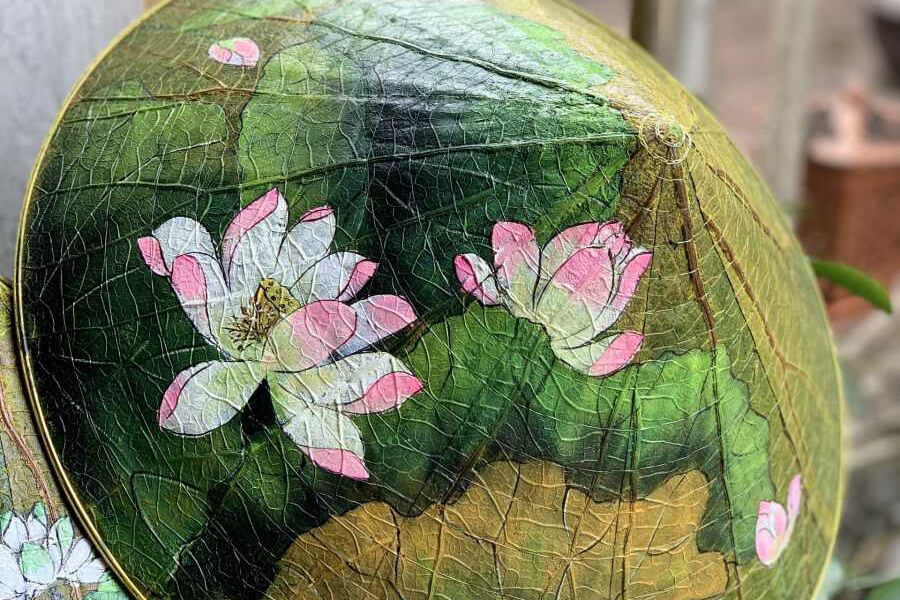
Distinguished by regional variations, two prominent styles of the Non La stand out: the Non La of Chuong Village, nestled 30 kilometers southwest of Hanoi, and the Non Bai Tho from Hue, the ancient imperial capital of Vietnam. The Non Bai Tho, aptly named the ‘poem conical hat,’ bears intricate depictions of Vietnamese poems and folklore crafted by skilled artisans, revealing themselves only under the caress of sunlight. Soft silk ties discreetly attached inside the hat ensure a secure fit for the wearer.
For those enchanted by this cultural artifact, Vietnam Travel orchestrates immersive day trips to the traditional conical hat-making villages. Here, travelers gain insight into the craft, participating in the creation process to craft their unique hats. A treasure trove for visitors seeking meaningful souvenirs, the Non La stands as a symbol of Vietnam’s heritage, transcending age, gender, and racial boundaries—an emblematic piece representing the soul of the Vietnamese people.
Ao Tu Than – Four flapped Dress
In the trove of Vietnamese cultural heritage, the Ao Tu Than stands as a silent testament, predating the elegant Ao Dai and revered as one of the country’s most enduring relics. Its origins shrouded in the mists of time, this enigmatic garment found its semblance immortalized on the surface of the Trong Dong, a copper drum sculpted millennia ago.
At its core, the basic form of the Ao Tu Than comprises three integral components, each weaving a story of tradition and grace: the “Yếm,” an ancient bodice veiling the chest as an undergarment; a lengthy skirt cascading from the waist, and a flowing tunic serving as the outermost layer. This ornate tunic gracefully splits into four distinct flaps, known as “than.” The back flaps are melded together, forming a complete flap, while the front flaps are brought together with a silk sash cinched at the waist, resembling a belt. In its inception, natural hues derived from dyes extracted from yam, tropical-almond leaves, or earthy mud embellished the Ao Tu Than. Yet, in contemporary times, this exquisite attire is no longer a staple in the daily lives of locals. Instead, it finds resurgence in various festivals and regional events, adorned in more vibrant and diverse colors across the bodice, skirt, and tunic layers.
For a riveting glimpse into this traditional ensemble, the Lim festival in Bac Ninh Province offers a breathtaking spectacle. Named as one of the ten Great Festivals in Vietnam, this cultural extravaganza showcases female folk singers draped in the regal Ao Tu Than, bedecked with unique accessories that further enliven the attire’s allure. Adorned with “Khan Mo Qua,” a striking black crow’s beak kerchief crafted from substantial fabric, complemented by “Guoc Moc,” a pair of wooden clogs, and crowned by “Non Quai Thao,” a distinct conical hat featuring elegantly dangling fringes on either side.
The Ao Tu Than, a relic from the annals of time, stands as a living canvas of Vietnam’s heritage, resonating with tales of tradition and grace, encapsulated in its timeless elegance and resplendent cultural significance.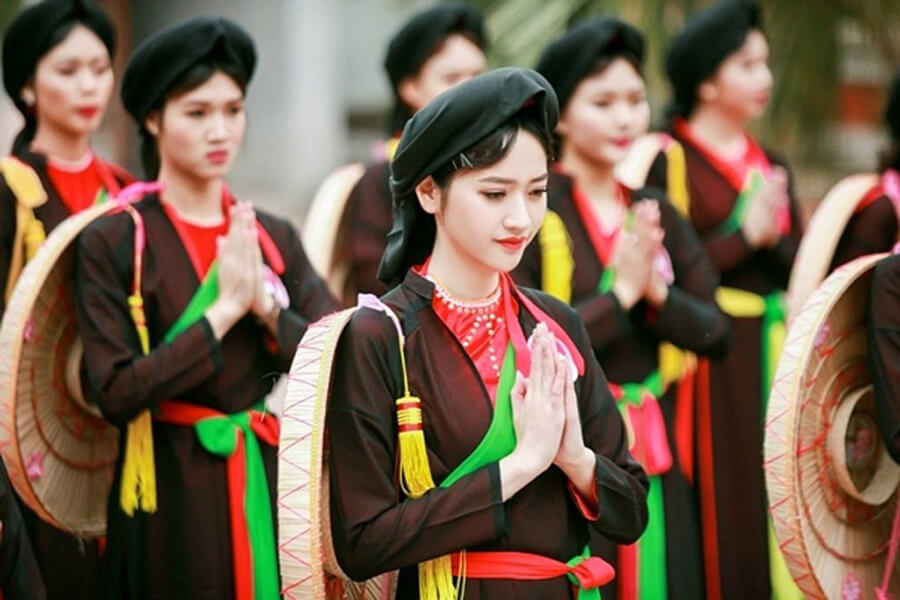
AO BA BA – The Shirt of Madam Ba
Amidst the lush tapestry of Southern Vietnam’s Mekong Delta, a hidden gem unfurls in the form of the traditional Ao Ba Ba, a lesser-known yet deeply cherished attire that graces the daily lives of the local populace. Enchanting images emerge as one navigates this picturesque region—scenes of the Ao Ba Ba shimmering beneath the verdant canopy of coconut groves, adorning rowing boats drifting along the rivers, and dotting the vibrant bustle of floating markets.
The Ao Ba Ba, a collarless shirt, features a meticulously crafted design. Its back is fashioned from a single, straight piece of cloth, while the front flap gracefully divides into two sections, adorned with a row of buttons cascading from the neckline down to the midriff. This intricately tailored shirt finds its perfect companion in long trousers, often in shades of pristine white or deep black. The choice of colors and materials for this ensemble is an artistic reflection of individual preferences. Traditionally, the hardworking farmers and peasants of the Mekong Delta favored dark hues like black or brown, as these colors were not only practical but also easy to maintain and clean, especially during their toil in the rice fields. Crafted from humble materials such as single fabrics, pungent fabrics, or linoleum, these garments boast a quick-drying attribute after each wash, catering to the demands of daily wear. Notably, two additional pockets near the hem add a touch of practicality, providing a convenient storage space for essentials.
This unassuming garment, the Ao Ba Ba, holds a place of reverence in the daily lives of both men and women across the Mekong Delta. While it’s a staple in everyday activities, during special events or festive occasions, individuals opt for lighter shades such as white or ash gray. The affluent class, in their pursuit to display opulence, favors colors like young, pale blue coupled with more luxurious fabrics like silk or satin.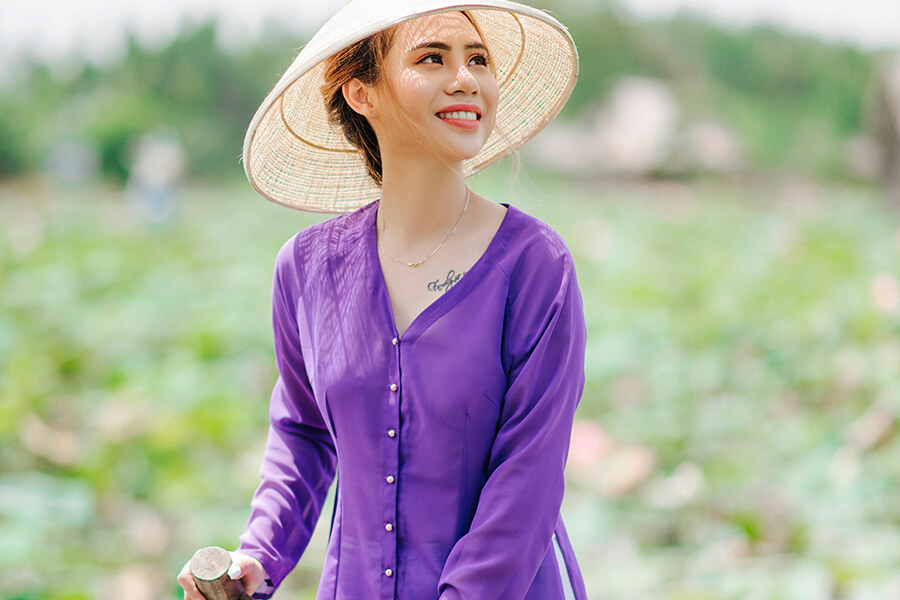
Throughout generations, the basic design of the Ao Ba Ba has endured, evolving subtly to align with contemporary fashion sensibilities. Particularly for women, the modern iteration is characterized by a more tailored silhouette, embracing the body to accentuate the graceful curves of the feminine form.
Notably, the Ao Ba Ba is often paired with a checkered scarf, also known as a bandana. Whether in black and white or brown and white, this unassuming accessory adds a gentle yet distinct accent to the wearer’s casual style.
In the mosaic of Southern Vietnamese beauty, the ensemble of Ao Ba Ba, conical hat, and bandana collectively creates an aura of grace and elegance, serving as a distinctive hallmark of the region’s sartorial tradition and cultural legacy.
VIETNAMESE TRADITIONAL COSTUMES OF ETHNIC GROUPS
Traditional costumes of H’Mong ethnic group in Vietnam
Within the heart of Vietnam’s Northern and Western mountainous regions, a captivating community, the H’mong hill tribe, weaves a tapestry of diversity and cultural richness. Residing predominantly in areas like Ha Giang, Lao Cai, Lai Chau, and Son La, this tribe, representing about 1.2% of the nation’s population, stands as the eighth largest minority ethnic group in Vietnam.
The H’mong people, segmented into distinct subgroups, are distinguished by the vibrant spectrum of colors adorning their traditional attire: Black, White, Blue, Red, and Flower H’mong.
Adorned with a vibrant cultural identity, the traditional costumes of H’mong women are a testament to intricate artisanship and vibrant hues. Crafted from linen, these elaborate ensembles feature a kaleidoscope of embroidered motifs, creating a resplendent visual narrative. The ensemble comprises a striking deep V-chest shirt, accompanied by a distinctive two-piece overall that adorns both the front and back. Completing the ensemble is a resplendent, large belt, a headscarf, leggings, and a truncated cone-shaped gathered skirt. A symphony of colors and meticulous handmade designs adds to the allure, elevating the wearer’s beauty and distinction. Complementing these elaborate costumes, women embellish themselves with an array of handcrafted silver jewelry, from earrings and necklaces to bracelets and rings, adding a further layer of beauty and individuality.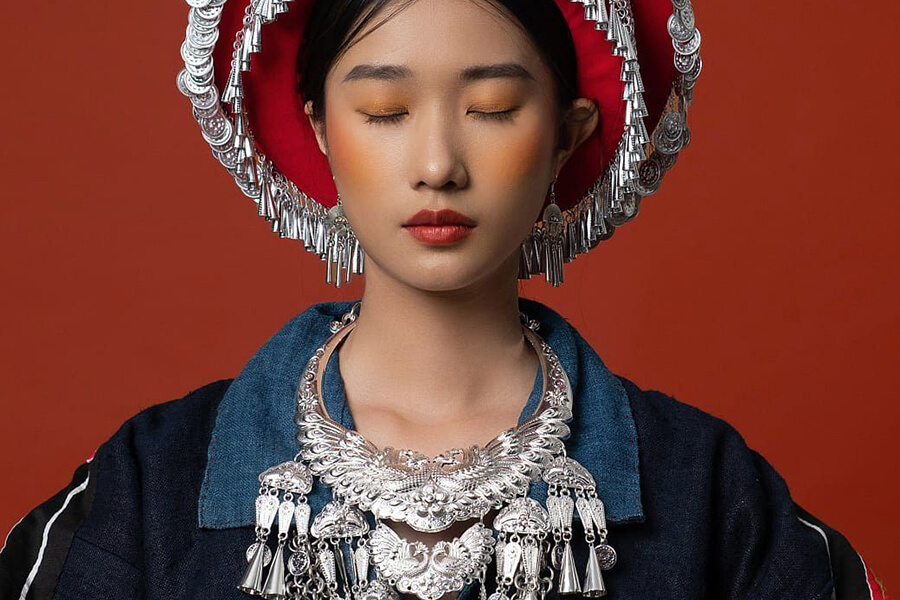
The men of the H’mong tribe, in their sartorial expression, don a distinctive attire marked by a sleeveless shirt with a chest vent, adorned with four pockets and four buttonholes. Their attire is complemented by drain-pipe, lamé-style trousers, reflecting a simple yet elegant fashion tradition.
Woven into the fabric of their attire, the H’mong tribe’s traditional costumes serve as a vibrant emblem of their cultural heritage, resonating with the artistry, vibrancy, and individuality that define this unique community. These intricately designed garments stand as living testaments to the artistic prowess and cultural depth of the H’mong people.
Traditional costumes of Thai ethnic group in Vietnam
Enveloped in the enchanting tapestry of Vietnam’s northwestern expanse—Lai Chau, Dien Bien, Son La, and Hoa Binh—dwells the captivating Thai ethnic group, adorned in traditional garments that leave an indelible impression on those who encounter them.
Amidst this cultural panorama, the Thai women stand resplendent in their traditional attire—a fusion of elegance and grace. They don a close-fitting blouse coupled with a sweeping black long skirt, the ensemble embellished with a cloth belt in hues of blue, green, or pink, harmoniously connecting the blouse and skirt. The pristine combination of a white blouse and black skirt exudes a timeless charm, while the green belt complements this pairing.
The pièce de résistance of their attire is the intricately woven brocade headscarf, locally known as “Khăn Piêu,” a masterful creation that adds an air of sophistication and modesty to their ensemble. Completing the ensemble, silver jewelry adorns their attire, elevating its elegance.
Traditionally differentiated, the black Thai women don a black blouse with a high collar, while their white Thai counterparts favor a white blouse adorned with a V-shaped collar. Notably, the blouse features two rows of silver buttons adorning the front—a unique touch that bespeaks gender and marital status. The female buttons are delicately shaped like butterflies and are embedded in one row, while the male butterfly-shaped buttons grace the other. An intriguing detail reveals itself in the Thai tradition: unmarried women wear a blouse bedecked with an even number of buttons, while the married women elegantly display an odd number of buttons, a subtle yet distinctive tradition embedded in their clothing.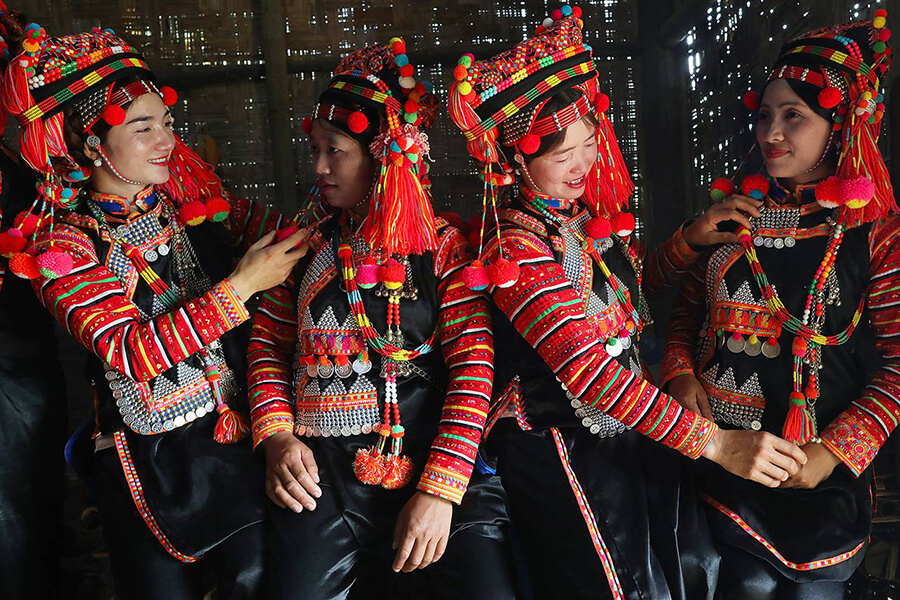
This distinctive and ornate attire of the Thai ethnic group in Vietnam’s northwestern region stands as a testament to their cultural richness, combining tradition, elegance, and subtle symbolism in the intricate details of their attire. As they grace the landscape with their traditional garments, the Thai women embody a timeless charm and cultural depth that captivates and lingers in the memories of all who have the privilege of encountering this visual symphony.
Traditional costumes of Cham ethnic group in Vietnam
Nestled along the coastal tapestry of central Vietnam, the Cham people, deeply rooted in a culture influenced by ancient Indian traditions, possess an attire that, although not as vividly hued as some in the region, exudes its own subtle yet captivating beauty.
Embracing a unisex style, both Cham men and women don long, one-piece sarongs or cloth wraps. Men elegantly fasten shirts down the center, adorned with intricate buttons, while women opt for long-sleeved pullover blouses. The attire’s centerpiece, the waistband, is an exquisite element, embellished with lustrous, golden iridescent shades and intricate detailing. During significant events such as the Kate New Year festival, the Ramuwan festival, weddings, or celebrations marking a girl’s transition to adulthood, Cham women don vibrant, enchanting long dresses. The attire assumes a white hue when attending religious ceremonies. Uniquely, the Cham women’s dresses lack split flaps, allowing their movements to be light, flowing, and inherently captivating. Complementing this ensemble is the indispensable headscarf, an emblem of cultural expression. Reserved and inclined to communicate through their eyes, lips, and cheeks, the Cham women offer subtle interactions, where a gentle glance or smile often substitutes for a conventional greeting.
Across the annals of time, the modern Cham long dress has seen subtle modifications while upholding its traditional essence. The attire now harmoniously integrates two intertwined, embroidered cloth belts, enhancing the wearer’s natural curves and adding to the allure of the ensemble.
The Cham attire, with its understated yet profound charm, epitomizes a cultural legacy that elegantly merges tradition with modern adaptations. Their attire serves as a captivating testament to the Cham people’s cultural richness and their unique form of expression that transcends the boundaries of language, relying instead on subtlety, grace, and the allure of timeless tradition.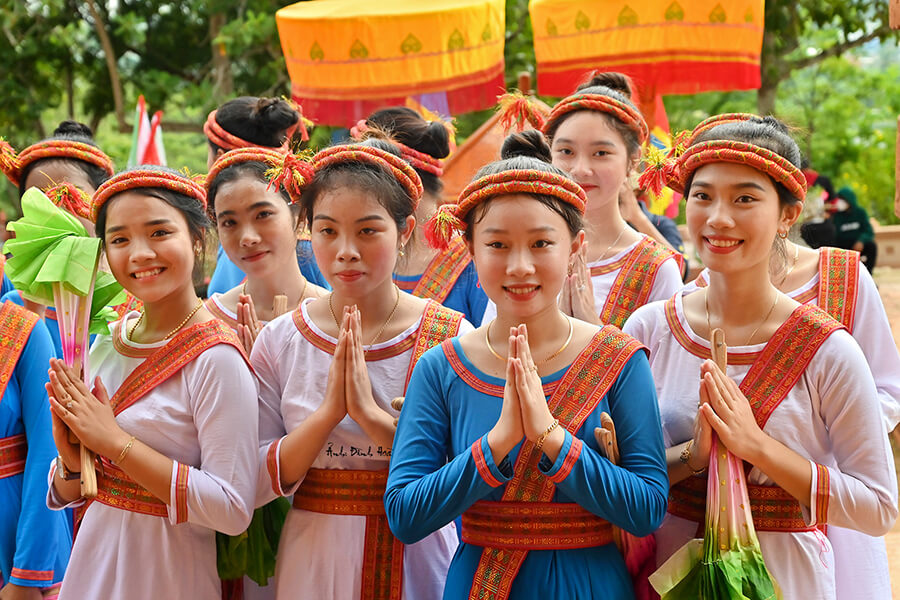
FINAL LINES
In the ever-evolving landscape of Vietnamese fashion, the traditional costumes have gracefully navigated the waves of modernity and Western influences. While contemporary and more practical clothing styles have emerged, the allure and quintessential traits of traditional attire persist, etching a captivating narrative of Vietnam’s rich heritage.
The Vietnamese people, anchored in their distinct dressing style, continue to celebrate and uphold their cultural legacy. Despite the fusion with modern fashion trends, the essence of elegance and timeless charm embedded in the traditional costumes remains steadfast, a hallmark of the country’s unique identity.
This enduring elegance, rooted in cultural tradition, acts as a magnetic pull for travelers venturing into the captivating landscapes of this stunning S-shaped country. The traditional attire, with its intrinsic beauty and unyielding essence, beckons to explorers, offering a glimpse into Vietnam’s rich cultural tapestry and serving as a living testament to the nation’s grace and allure.

